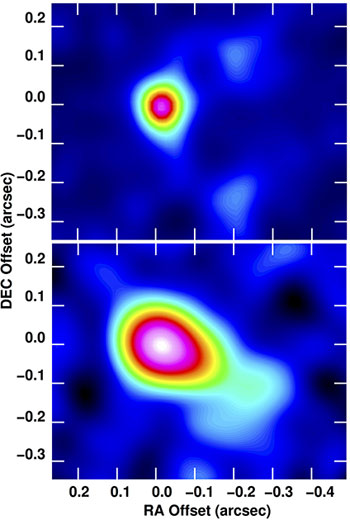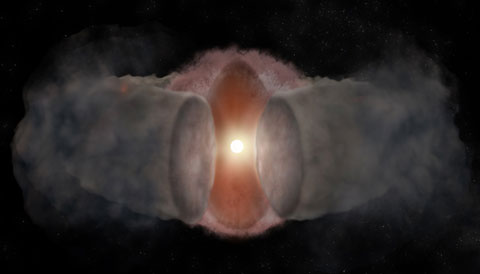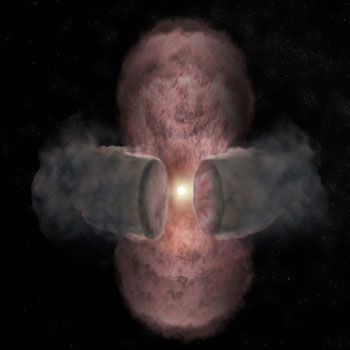A team of astronomers took the long view (18 years long, in fact) and caught a star in the act of forming.
Astronomers must often piece together patchwork quilts of observations to learn the history of the universe. Stars and galaxies usually evolve over time scales much longer than human lives, so rather than watch individual stars or galaxies develop, observers sew together images of many objects at different stages to tell their life story.
But every now and then, a star tells its own story.
In a star-forming region dubbed W75N(B), Carlos Carrasco-González (National Autonomous University of Mexico) and his colleagues watched what will one day be a massive and luminous B star evolve over a period of 18 years.
As the protostar grew, drawing in gas from its surroundings, it threw off a small fraction of those particles in a protostellar wind. Back in 1996, observations showed this wind streaming outward in all directions. But 18 years later, the team reported in the April 3rd Science, the wind had transformed, flowing faster and farther along the star’s poles. Seen in real-time, the wind’s changing shape reveals how the forming star responds to its surroundings.
Forming Massive Stars

Carrasco-Gonzalez & others / NRAO / AUI / NSF
Embedded within W75N(B) are two radio-emitting protostars known as VLA 1 and VLA 2. Once nuclear fusion ignites, the stars will contain between 10 and 15 times as much mass as the Sun. VLA 1 appears to be farther along toward ignition than VLA 2 and boasts a thin, radio-emitting jet in a 1996 set of observations. Taken by José-María Torrelles (Institut d'Estudis Espacials de Catalunya, Spain), those same observations showed VLA 2 to be an unresolved dot of radio emission.
The 1996 observations also recorded emission from water-vapor masers. The water vapor emits a spectral line at microwave wavelengths (22 GHz) that is amplified as protostellar winds force their way through the natal cloud of gas and dust.
In VLA 1, water masers traced out a jet 1,300 astronomical units (a.u.) long. In VLA 2, though, the water masers traced out not a line, but an expanding sphere 185 a.u. across — VLA 2 wasn’t emitting a jet, but a wind in all directions.
That changed in 2012, when new water maser observations showed that VLA 2’s once-spherical and still-expanding wind had elongated into a potato shape, now measuring 354 a.u. by 190 a.u. Carrasco-González’s team confirmed the elongation by observing radio continuum emission with the upgraded Jansky Very Large Array in 2014.
Channeling Winds

Bill Saxton / NRAO / AUI / NSF
The entire outflow is probably transient, the team puts forth, fueled by a sudden increase in accretion onto the protostar roughly 25 years ago. A torus of dense dust and gas that surrounds the star —unseen in the observations due to the chaotic mess surrounding multiple forming stars — shepherds the outflow into an elongated shape.
“Their model is carefully done and well explained,” says Debra Shepherd, (formerly at National Radio Astronomy Observatory), who though not involved in the present study, has studied this star-forming region for years. “This kind of event is only seen in systems with accretion disks.”
But what drives the wind in the first place remains unanswered. Most models of stellar outflows invoke a magnetic field to launch and contain the particles, like the rubber skin of a hose collimates the water gushing out into a narrow stream. As charged particles flow in from the surroundings and onto the star, the magnetic field they carry gets so twisted up, it launches a small fraction of those particles outward in a narrow stream. This scenario likely explains VLA 1’s jet.

Bill Saxton / NRAO / AUI / NSF
But VLA 2’s wind wasn’t narrow to begin with, and even now that it has elongated, it’s still not narrow enough to suggest that magnetic fields play a significant role, Carrasco-González says. Still, the water maser measurements show that the magnetic field around the VLA 2 protostar has aligned itself to match the magnetic field around VLA 1 and the cloud’s larger-scale magnetic field, so the magnetic field is doing something.
Carrasco-González plans to continue monitoring this star-forming region, and especially its magnetic field, both on the large scales of the massive gas cloud, and on the smaller scales around the forming star itself. He and his team have a good shot at actually observing real-time changes in the near future.
“This will be a very interesting source to follow in the coming years,” Shepherd says.
 2
2
Comments
Anthony Barreiro
April 8, 2015 at 3:14 pm
I always want to know where things are in the sky, and how far away they are. A quick web search for W75N(B) revealed that it is about 4200 light years distant. It took a little more hunting to find a location, but Hutawarakorn and colleagues list the location of this star-forming region as RA 20h37m and Dec 42d27m. That would put it in Cygnus, between Deneb and Sadr. I suppose I would have to live a very long time before I would be able to see these stars start to shine in the Cygnus milky way, but it will be nice to look up at Cygnus before dawn tomorrow morning and know that they're doing their thing in their dark nebular cocoon.
Reference
Hutawarakorn, B.; Cohen, R. J.; Brebner, G. C. (2002.) "OH masers and magnetic fields in the bipolar outflow source W75N." MNRAS Vol 330, Issue 2, pp. 349-364., available at http://adsabs.harvard.edu/full/2002MNRAS.330..349H
You must be logged in to post a comment.
Anthony Barreiro
April 8, 2015 at 6:07 pm
Darn. Torrelles et al., in the article linked as "1996 set of observations" in Dr. Young's article, gives this star-forming region's right ascension and declination, and says it's in the Cygnus X complex. I missed that the first time I skimmed the article.
Torrelles et al. say the complex is at a distance of 2 kpc, or 6500 light years. I wonder where the discrepancy between 4200 and 6500 light years came from?
You must be logged in to post a comment.
You must be logged in to post a comment.